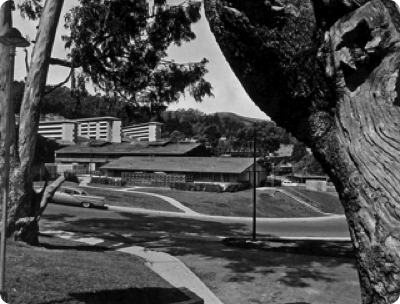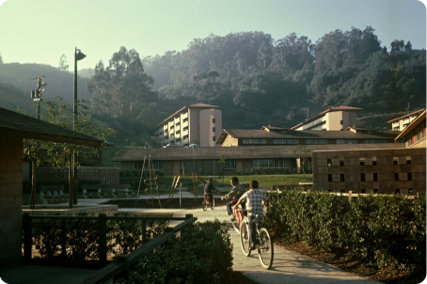
Where is Golden Gate Village?
Golden Gate Village is a public housing complex that makes up a large part of Marin City. It’s located near Sausalito in southern Marin County, California.
When was Golden Gate Village built?
Golden Gate Village was completed in 1961. The primary intention was to provide housing for Black shipyard workers who had been employed at Marinship in Sausalito during World War II but were prevented from buying homes in Marin County after the war due to restrictive covenants and redlining.
How big is Golden Gate Village?
Golden Gate Village has 296 live-in apartments, comprised of 44 one bedroom units, 132 two bedroom units, 111 three bedroom units, and nine four bedroom units. There are an additional four units used for other purposes. The mixed-use development includes eight mid-rise buildings with a total of 168 units, and 20 low-rise buildings with 132 units. The entire complex is nestled on about 32 acres of a 365-acre sloping site.
How many people live in Golden Gate Village?
GGV is home to approximately 700 low-income residents, including children. About 400 are people of color, making Golden Gate Village the largest community of majority-Black residents in a county where African-Americans account for only 2% of the total population.
Who designed Golden Gate Village?
in 1957 the Housing Authority of Marin chose Frank Lloyd Wright protege, Aaron Green, and another noted local architect, John Carl Warnecke, to design the 300-unit complex. Green was the lead architect for all building design and campus layout (master plan); Warnecke's office did the construction documents. Green also applied Wright’s seminal philosophy of “organic architecture” to the project. Tenets of this philosophy include the idea that architecture should be integrated with the environment and evolve from the nature of the site, itself. Renowned landscape architect, Lawrence Halprin, directed the physical landscaping, including overall layout, plant selection, terraces and play areas.
In 1964, Green and Warnecke were chosen by the federal Public Housing Administration for the First Honor Design award for Golden Gate Village from among 700 entrants nationwide.
Why is Golden Gate Village on the National Historic Register?
To be considered for inclusion in the Register, a property must meet at least one of four criteria. In its application, Women Helping All People (a non-profit headquartered at Golden Gate Village) identified three:
1. Event/Development. Association as a product of post-WWII urban development in Northern California and as this complex relates to American public housing of the same period.
2. Significant Persons. Due to the advocacy of two women: Marin County Supervisor Vera Schultz, the first woman elected to this position in the County, and Mary Summers, the first female director of Marin County's Planning Department.
3. Historic Resource. Association with four prominent mid-20th century designers: architect Aaron Green, architect John Carl Warnecke, landscape architect Lawrence Halprin, and city planner Lawrence Livingston, Jr.
At the time Women Helping All People submitted its application, architectural historian Alison Garcia-Kellar wrote: “While it is clear these buildings as a public housing project are unique to Marin County, the project is further distinctive, from a design perspective, as part of a nationwide, post–World War II public housing program. This is largely because of its relationship to the existing hillside site and the way in which the buildings interact with each other. A mini ecosystem was created for this specific community, most of which is essentially intact.”
What does it mean to be on the National Historic Register?
The National Register is the official list of historic places in our nation that are worthy of preservation. For rehabilitation purposes, this designation protects Golden Gate Village from major alterations to its existing design. Unfortunately, it does not provide unilateral protection in the event the Marin Housing Authority wanted to alter the existing character of the complex significantly by constructing additional, new buildings (which it does). It does put major road blocks in the way of total demolition, but, again, these would not necessarily be insurmountable in the face of a determined bureaucratic entity.
Being listed on the Register does, however, mean that any proposed project that involved altering the resource would have to go through a Section 106 consultation process in addition to CEQA (and, possibly, NEPA) review. Because the Golden Gate Village listing is for a historic district, it covers not only the buildings but the entire property site, including parking lots, walkways and open spaces.
In 1964, architects Aaron Green and John Warnecke were chosen by the federal Public Housing Administration for the First Honor Design award for Golden Gate Village from among 700 entrants nationwide. To this day, it is the only public housing complex in the country designed by award-winning architects.
What makes Golden Gate Village unique?
Golden Gate Village is the only public housing in Marin County that accepts children and families. It is also the only public housing complex in the country designed by award-winning architects.
What is the role of the Golden Gate Village Resident Council?
The Golden Gate Village Resident Council (GGVRC) is the duly elected representative for the tenants of Golden Gate Village, who comprise 70% of all Marin Housing Authority’s public housing residents in the County. In 2013, the GGVRC developed and has been advocating ever since for a Deep Green renovation plan for Golden Gate Village that includes Green New Deal technology, job training, and a path to home ownership for residents.
Their plan has been routinely ignored and their advocacy summarily dismissed for seven years by MHA and the Marin Board of Supervisors. Today, with the renewed focus on the Black Lives Matter movement and increasing awareness among whites of the ongoing effects of systemic racism, the GGVRC plan is gaining more and more support and prominent allies within the Marin community at large. With GGVRC directing the charge, the intention going forward is to give MHA and the Supervisors the opportunity to be on the right side of history willingly or not.


Courtesy John Carl Warnecke Archive, 1963
Courtesy Aaron Green Library, circa 1963, Ken Molino phontographer